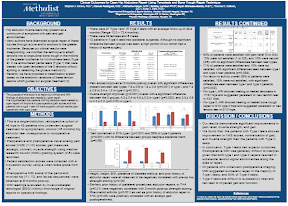Dr. Incavo and colleagues were invited to present their latest research findings, Kinematic Gait Analysis with Motion Capture Technology Following Total Knee Arthroplasty, Clinical Outcomes for Open Hip Abductors Repair Using Tenodesis and Bone Trough Repair Technique and Intraosseous Morphine Decreases Postoperative Pain in Total Knee Arthroplasty at the 2021 American Association of Hip and Knee Surgeons (AAHKS) Annual Meeting recently held in Dallas, TX.


Abstract – Kinematic Gait Analysis with Motion Capture Technology Following Total Knee Arthroplasty and Clinical Outcomes for Open Hip Abductors Repair Using Tenodesis and Bone Trough
Author(s): Katharine D. Harper, MD; Bradley S Lambert, PHD; Jordan Ankersen, BS; Thomas C. Sullivan, BS; Terry A. Clyburn, MD; Stephen J. Incavo, MD;
Introduction: As popularity of total knee arthroplasty (TKA) has increased, so have the expectations of patients with regards to function and outcomes. This study uses motion capture to analyze knee kinematics and gait cycle to characterize return to function of the operative limb compared to the non-operative limb at 3 and 6 months following primary TKA. Methods A prospective control trial performed at a tertiary referral center. 28 patients completed pre-operative motion capture analysis, with 22 patients completing the 3-month, and 19 completing the 6-month assessment. Data was collected using a VICON® Motion Capture system. Subjects performed 6 trials of walking starting from a standing position. Data was analyzed at pre-op, 3- and 6-months post-op for gait parameters (step length, width, stride length), gait cycle, and kinematic measures (joint position and range of motion [ROM]). Results No between-limb differences were observed for step or stride length. Step width remained wider at 6-months post op than prior to surgery (2.2±0.6cm, p<0.01). A significant increase in gait speed was observed from 3-months to 6-months post-op (0.4±0.1 meters/sec, p<0.01). ROM for knee flexion was reduced by ~4-6° on average during pre-op in the TKA limbs compared to the control limbs. This difference only partially resolved for the complete gait cycle and swing phase, and was largely attributable to a reduced ability to achieve full extension (0°) in the TKA limbs across all time points (p<0.05). Conclusions Our study has shown that gait cycle and knee kinematics largely do not return to normal until 6 months post-operatively, despite reports of excellent patient outcomes and normalization of static measures up to 3 months earlier. This demonstrates the limitations of patient-reported outcomes on overall function, and may indicate a need for more in-depth post-operative evaluation of TKA patients to determine true dynamic function.
Abstract – Clinical Outcomes for Open Hip Abductors Repair Using Tenodesis and Bone Trough Repair Technique
Author(s): Kwan J Park, MD; Manuel Rodriguez-Perez, MD; Thomas C. Sullivan, BS; Bradley S Lambert, PHD; Brian Gilcrease-garcia, MD; Stephen J. Incavo, MD;
Introduction: Hip abductor tear can lead to chronic pain, weakness, and gait abnormalities. We report patients who had abductor tendon repair. Surgical treatment was based on the status of gluteus medius muscle: No detachment (type I) or avulsion (type II) from the greater trochanter. Methods: Type I tears were treated with tenodesis of the gluteus medius and minimus. Type II tears were treated with gluteus medius advancement into a bone trough in the greater trochanter. No patient had a combined abductor repair/THR. Pain (VAS), gait (normal/antalgic), muscle strength (0-5), MRI, and patient questionnaires were evaluated. Results: 45 hips (44 patients) had a minimum of 6 months follow-up (6-76 months). There were 27 Type I and 18 Type II tears. 87% of patients were female. 28% of type II patients (5/18) had a prior arthroplasty. Pain scores improved from 7.9 ± 0.5 to 2.1 ± 0.6 (p<0.001): 7.8 ± 0.6 to 1.9 ± 0.5 (p<0.001) in type I, and 7.9 ± 0.9 to 2.4 ± 1.2 type II (p<0.001). 9% had normal preoperative gait (11% type 1 and 6% type II) and at post-op 67% normal gait (p<0.001). Gait normalized in 81% type I (p<0.001) and 56% in type II patients (p<0.007) with no difference between groups despite a statistical trend (p=0.06). Muscle strength improved from 3.9 ± 0.3 to 4.6 ± 0.2 (p<0.001) overall. Postoperative MR imaging at 6-months was performed in 21 of the type I hips and 10 of the type II hips. For type I, MRI showed healed tenodesis in 17/21 hips, and, for type II, MRI showed healed bone trough repair in 5/10 type II hips. Conclusion: Abductor repair improved patient pain, and Type I tears had superior outcomes. MRI suggested successful repair in 81% of type I tears, and approximately 50% of type II tears.